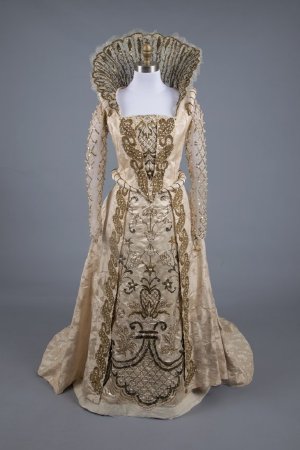Object ID:
2013.4.1
Label/Maker:
Ackermann, Rudolph
Date:
January 1809
Object Details:
The Ackermann illustration depicts a young woman wearing a classic, white, high-waisted, Regency walking dress. The dress reaches past the ankles to the floor and the long sleeves extend past the wrists; yet the most fetching part of this illustration are the shocks of golden color seen throughout the ensemble. The mop cap, shoes, and cape grab the viewer's attention through their paralleled coordination. The cape includes a ruffled neckline and is the highlight of this fashionable statement, which is embellished with patterned fur reminiscent of ermine. The cape also provides an outer layer for warmth while conveying a sense of modesty.
Reference:
Cultural Connections:
Both of these fashion pieces share a connection despite their intended uses. The ermine-influenced fur, that borders the cape in the Ackermann fashion illustration, suggests royal connotations. King Edward III of England outlawed the use of ermine during the 12th century to anyone who was not a member of the royal family. 4 Although this restriction eased, ermine-styled furs continued to identify the aristocracy. Even the cape's ruff hints at an earlier reference to styles Queen Elizabeth I might have worn. In this sense, the Ackermann illustration plays at the idea of symbolism associated with royalty and its significance regarding the history of dress. As with the Ackermann illustration, the Elizabethan-style opera dress also references royalty although more conspicuously. The large ruff, fine detailing, and choice of materials, all coincide with formal portraits of Queen Elizabeth I. It would not be surprising, therefore, if the designer, Marie Muelle, used these portraits as a starting place to embrace Renaissance style in drafting the opera costume. Since the dress was made in 1880, a 19th century perspective on dress of the 16th century is revealed through a stunning interpretation.
Reference:
4 "Ermine," Encyclopedia Britannica, June 6, 2020. https://www.britannica.com/animal/ermine-mammal



